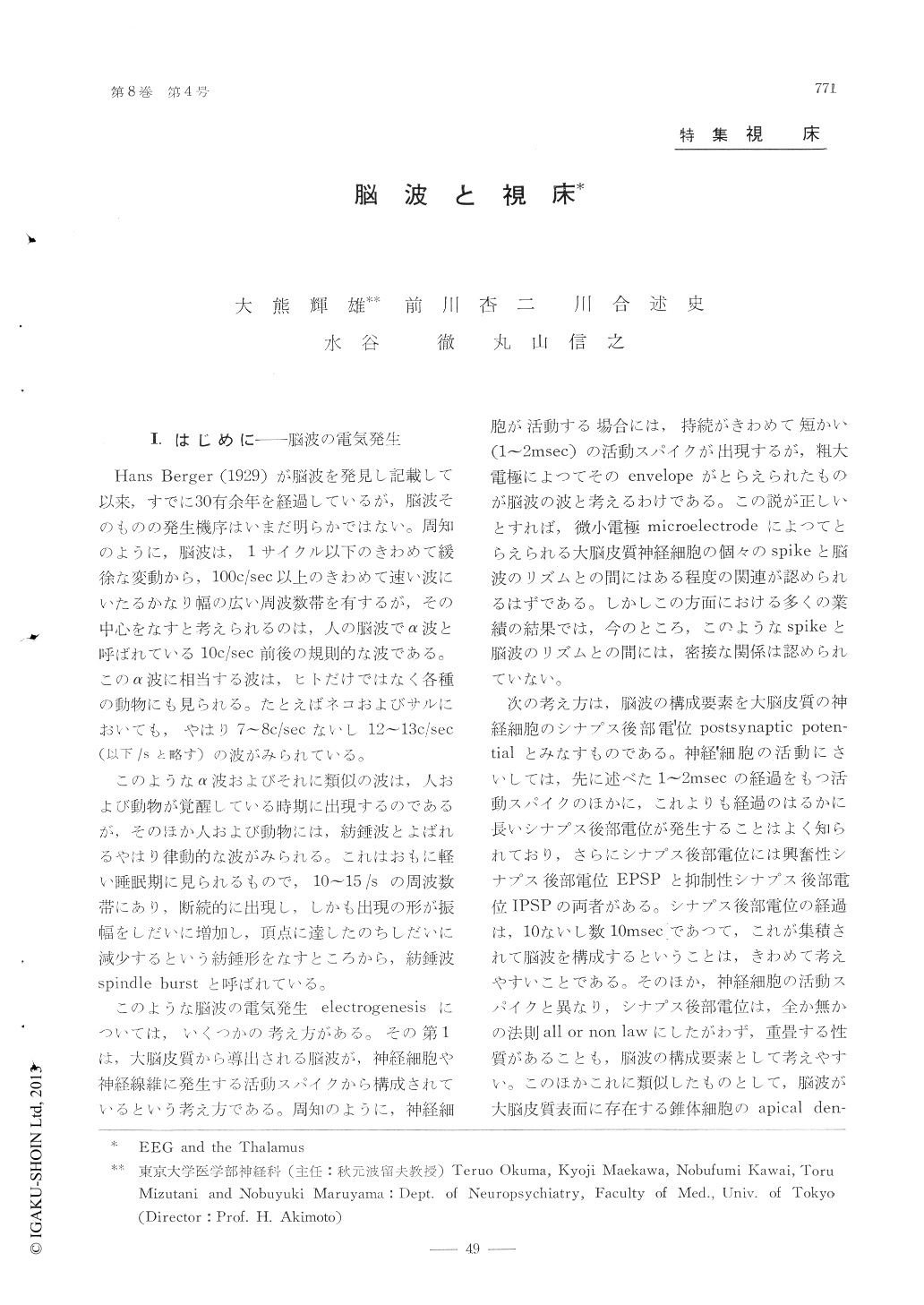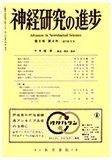Japanese
English
- 有料閲覧
- Abstract 文献概要
- 1ページ目 Look Inside
I.はじめに―脳波の電気発生
Hans Berger(1929)が脳波を発見し記載して以来,すでに30有余年を経過しているが,脳波そのものの発生機序はいまだ明らかではない。周知のように,脳波は,1サイクル以下のきわめて緩徐な変動から,100c/sec以上のきわめて速い波にいたるかなり幅の広い周波数帯を有するが,その中心をなすと考えられるのは,人の脳波でα波と呼ばれている10c/sec前後の規則的な波である。このα波に相当する波は,ヒトだけではなく各種の動物にも見られる。たとえばネコおよびサルにおいても,やはり7〜8c/secないし12〜13c/sec(以下/sと略す)の波がみられている。
このようなα波およびそれに類似の波は,入および動物が覚醒している時期に出現するのであるが,そのほか人および動物には,紡錘波とよばれるやはり律動的な波がみられる.これはおもに軽い睡眠期に見られるもので,10〜15/sの周波数帯にあり,断続的に出現し,しかも出現の形が振幅をしだいに増加し,頂点に達したのちしだいに減少するという紡錘形をなすところから,紡錘波Spindle burstと呼ばれている。
Since Berger's discovery of EEG, it has been suggested that there is the common pacemaker ofthe cortical EEG, somewhere in the subcorticalstructures. By Dempsey & Morison, it was established that there were two different systems in thethalamocortical relations, -the specific and the non-specific system, and the former is responsible forthe augmenting response and the latter for the recruiting response. The thalamocortical circuits hasbeen assumed to be the synchronizing system of thecortical EEG.
By Moruzzi & Magoun, the activating influenceof the mesencephalic reticular formation to the cortex was enclosed and it has been said that MRFis the arousal or desynchronizing centre of thewhole brain. A lot of research works has been carried out both in the field of clinical works-forexample as to the epileptic discharges and in thestereotaxic operation -and in the field of animalexperiments about the functional relationships between the cortico-thalamo-reticular systems.
We attempted to analyse the functional relationship between the mesencephalic reticular formation(MRF) and the thalamus in the desynchronizationand synchronization of the cortical EEG.
In order to examine the excitability changes ofthe thalamus and MRF, we picked up extracellularneuronal discharges of the thalamus and MRF bymicroelectrodes and investigated I) the spontaneousunit discharge patterns in relation to the electrocorticogram (ECoG). II) the influence of the recruiting stimulation of the nonspecific thalamicnuclei (NST) on the thalamic and MRF neuronaldischarges. III) the influence of the high frequency stimulations to the non-specific thalamic nucleiand MRF.
Cats immobilized by d-tubocrarine chloride ortlaxedil, were maintained on the artificial respiration. No general anesthetics was used. The non-specific thalamic stimuli of low (3-10c/sec) frequency changes the unit discharge patterns of boththalamus and MRF. There is diffusely induced inthe non-specific thalamic neurons a triphasic excitability changes short excitation, long lasting inhibition and then rather weak excitation. But generally the inhibitory effect is more prominent andlonglasting. When the spontaneous discharges ofNST or MRF neurons are active, the inhibitoryeffect of the recruiting stimuli are prominent, andwhen the spontaneous discharges are rather inactive, they act as the facilitation ; in general theformer cases are more remarkable than the latterin both thalamic and MRF neurons.
Thus the NST has a function which maintainsthe activity level of the thalamus and MRF at theintermediate level.
The high frequency stimuli to non-specific thalamic nuclei and MRF produce reciprocal inhibitory influences on each other.
The inhibitory influence of MRF stimulation onthe non-specific thalamic neurons is more powerfulthan that of the non-specific thalamic stimulation. MRF, when stimulated at high frequency, seemsto have two different actions on the desynchronization of EEG, that is, one is the tonic facilitatory effect on the cortical and specific thalamic neurons and the other is the tonic inhibitory effect onthe non-specific thalamic neurons.
Then the cortical desynchronization by MRF stimulation (in the cortical arousal reaction)provided that it may have only a supplementaryrole partially consists of the blocking of the thalamocortical reverberating circuit at the thalamiclevel.

Copyright © 1964, Igaku-Shoin Ltd. All rights reserved.


